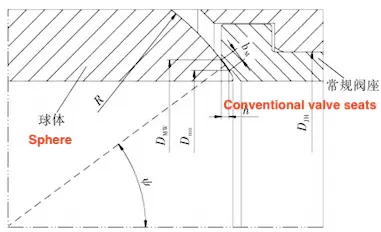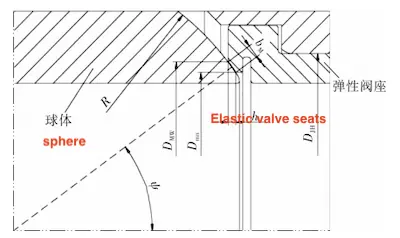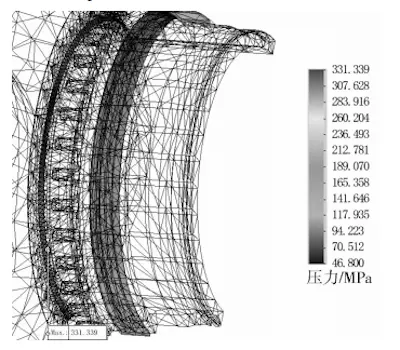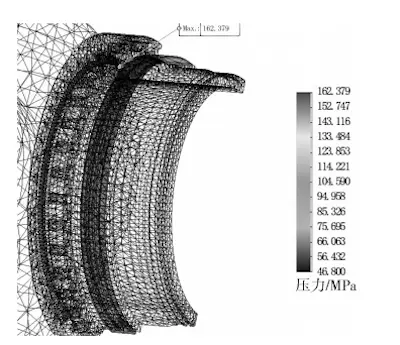High-Performance Metal Seated Ball Valves
On this page
Abstract: A high-performance elastic valve seat is designed for metal hard-sealed ball valves used in high-temperature and high-pressure working conditions on oil and gas production platforms. The design parameters and sealing performance test requirements of metal seated ball valves are introduced. The structural designs of elastic valve seats and conventional valve seats are compared, and the finite element method is used to simulate and analyze the stress distribution of the sealing rings of the two types of valve seats. Through high-pressure liquid sealing tests and high-pressure gas sealing tests, the effective sealing performance of the elastic valve seat is verified, especially under high-parameter working conditions. The sealing performance of the elastic valve seat is more prominent.
A ball valve is a spherical opening and closing part driven by a transmission shaft (valve stem) that rotates around the central axis of the transmission shaft to achieve the opening and closing action. It has the advantages of low flow resistance, reliable sealing, and easy operation. It is widely used in the fields of petroleum and natural gas, the chemical industry, steel, and new energy, and has a very broad market prospect. For the high-temperature and high-pressure working conditions of oil and gas production platforms, this paper designs a high-performance hard seated ball valve with an elastic valve seat to meet the requirements of high temperature, high pressure, and good sealing performance. This article briefly introduces the design and performance verification.
A ball valve is a spherical opening and closing part driven by a transmission shaft (valve stem) that rotates around the central axis of the transmission shaft to achieve the opening and closing action. It has the advantages of low flow resistance, reliable sealing, and easy operation. It is widely used in the fields of petroleum and natural gas, the chemical industry, steel, and new energy, and has a very broad market prospect. For the high-temperature and high-pressure working conditions of oil and gas production platforms, this paper designs a high-performance hard seated ball valve with an elastic valve seat to meet the requirements of high temperature, high pressure, and good sealing performance. This article briefly introduces the design and performance verification.
1. Design Parameters and Test Requirements of Metal Seat Ball Valve
1.1 Design Parameters
The nominal diameter of the metal seat ball valve is DN200 mm (NPS 8"). The nominal pressure is 42.0MPa (Class 2500); the design temperature is -29 to 235°C, and it is used for mix oil and gas. The valve body of the metal seat ball valve is made from ASTM A105, the ball ASTM A182 F6a CL2 plus STL12, and the valve seat ASTM A182 F6a CL2 plus STL6. Both STL12 and STL6 alloys are processed by the high velocity oxygen fuel (HVOF).
1.2 Sealing Performance Test Requirements
In addition to meeting API 6D (24th)—2014 "Specification for Pipelines" and the requirements of Article 9.4 of "Industrial Valves," a high-pressure gas sealing test shall be performed on the valve seat. During the high-pressure gas sealing test, the leakage of the valve seat seal shall not be greater than twice the requirement of ISO 5208-2015 "Industrial Valves—Pressure Testing of Metallic Valves" Rate D as specified in Appendix H of API 6D (24th)—2014, and shall not exceed the requirements of ISO 5208-2015 Grade Rate D.
2.1 Structural Design Calculation
Sealing is an extremely important indicator for evaluating valve performance. Many factors ensure the sealing of valves, such as the structural design and manufacturing process of the sealing pair, the material of the parts, the type of medium, and its nominal pressure. These factors are usually impossible to calculate accurately. The sealing structure of the hard seated ball valve consists of a valve seat and a ball. Both the valve seat and the ball have a spherical, smooth sealing surface that has been ground with high precision. The piston valve seat is pushed by external loads (spring force and medium pressure). The spherical sealing surface of the piston valve seat is well pressed against the ball, allowing the sealing pair to reach the sealing pressure ratio, thereby achieving sealing. The sealing structures of the conventional valve seat and the elastic valve seat are shown in Figure 1 and Figure 2.

Figure 1 Sealing structure using conventional valve seats

Figure 2 Sealing structure using elastic valve seats

Figure 1 Sealing structure using conventional valve seats

Figure 2 Sealing structure using elastic valve seats
2.2 Finite Element Simulation Analysis
The nominal pressure of the ball valve is 42.0MPa (Class 2500). The pressure-bearing parts (valve bodies and valve bonnets) and sealing parts (balls and valve seats) are prone to elastic deformation under high-pressure conditions, which affects the sealing performance of the ball and valve seat and can even cause sealing failure. Simulation finite element software is used to simulate the stress distribution of the sealing ring when the ball valve is in the closed position under high pressure, considering the static pressure of the fluid medium from the upstream end, as well as the sealing pressure of the fluid medium pushing the valve seat and making it close to the spherical surface. The ball and the seat are both made from ASTM A182 F6a CL2, and the influence of the sealing coating material on the deformation of the ball and the valve seat is not considered. The upper and lower shaft holes of the ball are fixed and constrained, and the sealing ring of the ball and the valve seat fit together. The entire internal area of the sealing ring is subjected to the static pressure of 42.6MPa from the high-pressure fluid medium, and the valve seat is subjected to the thrust of the fluid medium and the spring force that provides the initial sealing pressure ratio, totaling 330,000 N. Based on the mixed curvature, the ball valve is meshed, and two types of stress distribution cloud maps of the valve seat sealing ring are obtained by simulation analysis, as shown in Figure 3 and Figure 4.

Figure 3 Stress cloud diagram of conventional valve seat sealing ring

Figure 4: Stress cloud map of elastic valve seat sealing rings
From the stress cloud map shown in Figure 3, it can be seen that the stress value of the entire sealing ring of the conventional valve seat sealing pair is lowest at the left and right ends of the ball mouth, at 46.8MPa, and highest at the upper and lower axes, at 331.4MPa. The stress in the entire sealing ring belt area is less than the minimum yield strength of A182 F6a CL2, which is 380MPa as specified in Table 3. The sealing ring belt will not be permanently deformed under pressure, but the stress distribution of the entire sealing ring belt is extremely uneven, resulting in poor sealing of the sealing pair, which may cause leakage during testing. As can be seen from Figure 4, the stress value at the left and right ends of the entire sealing ring belt with the elastic valve seat sealing pair is lowest at 46.8MPa, and highest at the upper and lower axes, at 162.4MPa. The stress in the entire sealing ring belt area is less than the minimum yield strength of A182 F6a CL2, which is 380MPa. The entire sealing ring belt will not be permanently deformed under pressure. The stress value is evenly distributed, and the sealing effect is better than that of the conventional valve seat sealing pair.
Although the sealing surface pressure of the sealing pair of the conventional valve seat and elastic valve seat meets the formula, comparing the sealing ring belt stress cloud diagrams of Figures 3 and 4 shows that different valve seat structure designs and operating parameters have an important impact on the sealing effect. Especially when hard-seated ball valves are used under special or high-parameter working conditions, in addition to theoretical calculations, the influence of working condition parameters on the sealing effect of valve sealing pairs should be considered. This includes the stress and deformation of the ball, valve seat, and sealing ring when the high-pressure fluid medium acts on the ball and valve seat under high pressure.
The technical requirements of the metal -seated ball valve stipulate that the sealing performance of the ball valve shall not only meet the requirements of ISO 5208-2015 Grade Rate D in the high-pressure liquid sealing test but also undergo a high-pressure gas sealing test, and the leakage shall not exceed ISO 5208-2015 Grade Rate D. The leakage unit of metal-seated valves specified in ISO 5208-2015 is mm³/s, while the volume of the leaked test medium is generally measured by a measuring cup in mL during the valve sealing test. In this paper, minutes are used as the test time, and the measurement unit is mL/min. The maximum allowable leakage of NPS 8" and Class 2500 metal seals specified in ISO 5208-2015 is converted, and the results are shown in Table 1.
From the data in Table 1, it can be seen that the leakage allowed by the high-pressure gas test is much greater than that allowed by the high-pressure liquid test. Taking Rate D as an example, the leakage allowed by the high-pressure gas test is 300 times that allowed by the high-pressure liquid test. The high-pressure gas sealing test imposes higher requirements on the design and manufacturing process of the valve sealing pair. After the metal seated ball valve is assembled, it is tested at 1.1 times the working pressure according to the requirements of API 6D (24th)-2014. The leakage test results of the sealing pair of the two types of valve seat ball valves are shown in Table 2.
Table 1 Conversion results of the maximum allowable leakage of NPS 8", Class 2500 metal seated pair in ISO 5208-2015

Figure 3 Stress cloud diagram of conventional valve seat sealing ring

Figure 4: Stress cloud map of elastic valve seat sealing rings
From the stress cloud map shown in Figure 3, it can be seen that the stress value of the entire sealing ring of the conventional valve seat sealing pair is lowest at the left and right ends of the ball mouth, at 46.8MPa, and highest at the upper and lower axes, at 331.4MPa. The stress in the entire sealing ring belt area is less than the minimum yield strength of A182 F6a CL2, which is 380MPa as specified in Table 3. The sealing ring belt will not be permanently deformed under pressure, but the stress distribution of the entire sealing ring belt is extremely uneven, resulting in poor sealing of the sealing pair, which may cause leakage during testing. As can be seen from Figure 4, the stress value at the left and right ends of the entire sealing ring belt with the elastic valve seat sealing pair is lowest at 46.8MPa, and highest at the upper and lower axes, at 162.4MPa. The stress in the entire sealing ring belt area is less than the minimum yield strength of A182 F6a CL2, which is 380MPa. The entire sealing ring belt will not be permanently deformed under pressure. The stress value is evenly distributed, and the sealing effect is better than that of the conventional valve seat sealing pair.
Although the sealing surface pressure of the sealing pair of the conventional valve seat and elastic valve seat meets the formula, comparing the sealing ring belt stress cloud diagrams of Figures 3 and 4 shows that different valve seat structure designs and operating parameters have an important impact on the sealing effect. Especially when hard-seated ball valves are used under special or high-parameter working conditions, in addition to theoretical calculations, the influence of working condition parameters on the sealing effect of valve sealing pairs should be considered. This includes the stress and deformation of the ball, valve seat, and sealing ring when the high-pressure fluid medium acts on the ball and valve seat under high pressure.
The technical requirements of the metal -seated ball valve stipulate that the sealing performance of the ball valve shall not only meet the requirements of ISO 5208-2015 Grade Rate D in the high-pressure liquid sealing test but also undergo a high-pressure gas sealing test, and the leakage shall not exceed ISO 5208-2015 Grade Rate D. The leakage unit of metal-seated valves specified in ISO 5208-2015 is mm³/s, while the volume of the leaked test medium is generally measured by a measuring cup in mL during the valve sealing test. In this paper, minutes are used as the test time, and the measurement unit is mL/min. The maximum allowable leakage of NPS 8" and Class 2500 metal seals specified in ISO 5208-2015 is converted, and the results are shown in Table 1.
From the data in Table 1, it can be seen that the leakage allowed by the high-pressure gas test is much greater than that allowed by the high-pressure liquid test. Taking Rate D as an example, the leakage allowed by the high-pressure gas test is 300 times that allowed by the high-pressure liquid test. The high-pressure gas sealing test imposes higher requirements on the design and manufacturing process of the valve sealing pair. After the metal seated ball valve is assembled, it is tested at 1.1 times the working pressure according to the requirements of API 6D (24th)-2014. The leakage test results of the sealing pair of the two types of valve seat ball valves are shown in Table 2.
Table 1 Conversion results of the maximum allowable leakage of NPS 8", Class 2500 metal seated pair in ISO 5208-2015
| Test media | Leakage unit |
Rates | |||
| Rate A | Rate B | Rate C | Rate D | ||
| Water | mm3/s | No leakage | 2 | 6 | 20 |
| Water | mL/min | No leakage | 0.12 | 0.36 | 1.20 |
| Nitrogen | mm3/s | No leakage | 60 | 600 | 6000 |
| Nitrogen | mL/min | No leakage | 3.6 | 36.0 | 360.0 |
Table 2 Test results of leakages of ball valve seals with two types of valve seat structures
| Types | Test media | Leakage amount/(mL/min) | Results |
| Conventional valve seats | Water | 0.6 | Qualified |
| Conventional valve seats | Nitrogen | 830.0 | Not qualified |
| Elastic valve seats | Water | 0.0 | Not qualified |
| Elastic valve seats | Nitrogen | 34.0 | Not qualified |
As can be seen from Table 2, the leakage of the sealing pair during the liquid sealing test of the ball valve designed with a conventional valve seat structure meets the requirements of ISO 5208-2015 Grade Rate D, but the leakage of the sealing pair during the high-pressure gas sealing test far exceeds the requirements of the standard, rendering the test conclusion unqualified. The leakage of the sealing pair during the liquid sealing test and high-pressure gas sealing test of the ball valve designed with an elastic valve seat structure meets the requirements of ISO 5208-2015 Grade Rate D. The leakage of the sealing pair in the high-pressure liquid test even meets the highest grade Rate A of ISO 5208-2015, and the leakage of the sealing pair in the high-pressure gas test can meet the requirements of ISO 5208-2015 Rate C. It can be seen that the ball valve with an elastic valve seat structure design has excellent sealing performance.
4. Conclusion
By optimizing and upgrading the conventional valve seat structure of the metal seated ball valve, a high-performance elastic valve seat structure is designed, greatly improving the sealing performance of the ball valve sealing pair. The sealing performance test shows that, compared with the conventional valve seat, the elastic valve seat has a better sealing effect in high-parameter and high-temperature working conditions and can meet the requirements of these conditions.



